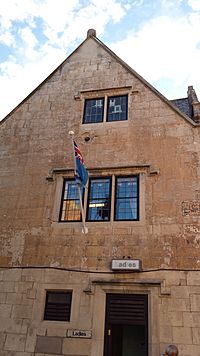Battle of Weymouth facts for kids
Quick facts for kids First Battle of Weymouth(The Crabchurch Conspiracy) |
|||||||||
|---|---|---|---|---|---|---|---|---|---|
| Part of The First English Civil War | |||||||||
 RAFA Club with an embedded cannonball |
|||||||||
|
|||||||||
| Belligerents | |||||||||
| Commanders and leaders | |||||||||
| Lewis Dyve William Hastings |
William Sydenham | ||||||||
| Strength | |||||||||
| 1,500 | 1,200 | ||||||||
The Battle of Weymouth was actually two battles and a secret plan called the Crabchurch Conspiracy. They all happened in 1645 during the First English Civil War. In these events, some people who supported King Charles I (called Royalists) tried to take control of the important port towns of Weymouth and Melcombe in Dorset.
Contents
Why Weymouth Was Important
The English Civil War in the West
The First English Civil War started in 1642. At that time, people in Dorset county were divided. Those in the south and in bigger towns usually supported the Parliamentarians. People in the countryside and the north often supported the Royalists.
A local politician, Sir Walter Erle, made sure that the ports of Weymouth, Lyme Regis, and Wareham were controlled by Parliament. Portland Castle was also under Parliament's control.
Dorset wasn't a huge or super important county. It didn't have big cities or a lot of factories. But its ports were useful for moving troops and supplies. Armies from both sides often marched through Dorset to get to bigger battles in places like Devon.
Who Controlled the West Country?
Control of the West Country kept changing hands. By the end of 1643, most of the area was held by the Royalists. Only a few towns like Plymouth, Poole, and Lyme Regis were still held by Parliament.
However, in the summer of 1644, a Parliamentarian leader named Earl of Essex moved through the region. He took control of most of Somerset and Devon for Parliament. But then his army got stuck in Cornwall and was cut off from help.
His army was badly beaten at the Battle of Lostwithiel in September. The soldiers scattered back into Dorset. After this, only Plymouth and Taunton were important Parliamentarian towns in Cornwall, Devon, and Somerset. In Dorset, Lyme Regis, Poole, and Weymouth stayed under Parliament's command.
Weymouth's Defenses
Weymouth was protected by earth walls and ditches. But it wasn't a very strong place to defend against a big attack. The harbor was safe because of Sandsfoot Castle. However, the town itself didn't have many strong forts.
The Royalists had taken Weymouth in August 1643. But the Earl of Essex made them give it up in 1644. William Sydenham became the new governor of Weymouth. He brought his soldiers to protect the town. By the autumn, new forts like Nothe Fort and Chapel Fort were built. More earthworks were also added around the town.
The First Battle of Weymouth
A Secret Plan: The Crabchurch Conspiracy
Even though things seemed calm, some Royalist supporters were still in Weymouth. They were secretly planning to give the town back to the King's forces. This secret plan was led by Fabian Hodder. He paid people £5 to join his cause.
When Hodder was ready, his wife, Anne, wrote a letter to Sir Lewis Dyve in Sherborne. A widow named Elizabeth Wall delivered the letter.
The Surprise Attack
Just after midnight on February 9, 1645, a small group of Royalist soldiers crossed the narrow water from Portland Castle. They met up with their secret supporters in Weymouth. These supporters wore white handkerchiefs on their arms. They used the secret password "Crabchurch" to recognize each other.
The attack surprised the Parliamentarian soldiers. The Royalists quickly captured Chapel Fort and Nothe Fort. But the Parliamentarians soon recovered and fought back. The forts were strong, so the Royalists held them even though they had fewer soldiers.
The next day, Dyve and William Hastings (the governor of Portland Castle) arrived with 1,500 men. They cleared out any remaining Parliamentarian resistance. They then took control of the town for the King. They also tried to kill Governor Sydenham, but they failed. However, Sydenham's brother, Francis, died in the first attack. This event became known as the Crabchurch Conspiracy.
The Parliamentarian defenders, led by William Sydenham, escaped to nearby Melcombe. At that time, Melcombe was only connected to Weymouth by a drawbridge. The two sides then started firing cannons at each other across what is now Radipole Lake and the old harbor.
The Second Battle of Weymouth
Parliament Fights Back
To get Weymouth back, Parliament sent the warship Constant Reformation. It was led by William Batten and had 200 sailors from Poole. Also, 100 cavalry soldiers led by James Heane managed to get through enemy lines. They met up with the Parliamentarians in Melcombe.
In total, there were 1,200 Parliamentarian soldiers in Melcombe. They faced 1,500 Royalists in Weymouth. The Royalists had more men, but they were not as experienced.
A large Royalist army of 4,500 men, led by Lord Goring, was nearby in Dorchester. But they didn't get involved in the fighting between Weymouth and Melcombe.
Recapturing the Town
On February 27, Sydenham saw his chance. He captured a Royalist supply convoy that was heading to Weymouth from Dorchester. When Dyve moved his troops to get the convoy back, the Parliamentarians attacked the bridge. They used 150 musketeers (soldiers with muskets). They took the town and eventually both forts.
Lord Goring immediately marched to retake the town with 6,500 men. But Sydenham and Batten fought them off. Most of the Royalists who were part of the Crabchurch Conspiracy were punished for their actions.

